Red Glows In Grey Istanbul
Eating Well Is The Best Revenge
by Diana Farr Louis
 ATHENS, Greece—(Weekly Hubris)—1/3/10—To say that I arrived in a downpour would be an understatement. The taxi from Ataturk Airport into town seemed to be tunneling under a fathom of water. Every so often it would surface like a breaking whale, spewing rollers on either side. Through the frenetic wipers, I could barely distinguish between the pewter sky, the steely Bosphorus and the murky outlines of the new apartment and office buildings that broadcast Istanbul’s growth since my last visit on the cusp of ‘87.
ATHENS, Greece—(Weekly Hubris)—1/3/10—To say that I arrived in a downpour would be an understatement. The taxi from Ataturk Airport into town seemed to be tunneling under a fathom of water. Every so often it would surface like a breaking whale, spewing rollers on either side. Through the frenetic wipers, I could barely distinguish between the pewter sky, the steely Bosphorus and the murky outlines of the new apartment and office buildings that broadcast Istanbul’s growth since my last visit on the cusp of ‘87.
When we splashed to a halt under the Galata Tower, my destination, the clouds burst with a gusto that made the earlier rain look like a shower. I struggled to shelter with my bag and waited for Daisy to appear. She emerged on the square in a long black coat, delighted smile belying her funereal garb.
I followed her down a hill of glistening gray cobblestones, one dark figure among many, past sodden storefronts lapped by sooty rivulets.
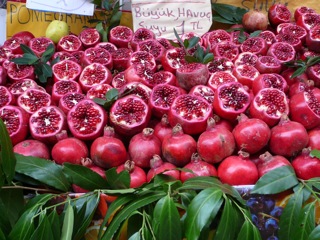
Until, round a corner, a battery of halved pomegranates shone like stoplights through the gloom. We had reached the juice souk, a cluster of three or four shops so bright and colorful they made me laugh out loud.
There was no question of passing them by. We nipped inside and sat down, instantly cheered by the glow and the waiter’s welcome. A few minutes later, I was sipping my first glass of fresh pomegranate juice, which is just as gladdening to drink as it is to look at.
Half an hour later, the deluge had dwindled to drizzle, so we extricated ourselves from the cozy, rosy juice shop and bumped the suitcase down to D’s building and then up her four flights of stairs.
There the rosiness transmogrified into a simple but more-ish red lentil soup, flavored with chili pepper flakes and cumin. Even though the orangey pulses turn yellow with cooking, they still warm the cockles of your heart. Never mind chicken soup for the soul; try Turkish red lentils.
Over the next two days, my vision of Istanbul as a grey city persisted independent of the weather, but flashes of red kept sparking in the most unexpected places.
Mercifully, the rain had stopped by morning but the sun was still playing coy. It didn’t matter for we spent it inside the bazaar, visiting Osman the Kurd’s weavings emporium. A tiny room down a corridor that looks like all the others and up a hidden staircase, this was a paradise stacked from floor to ceiling with wondrous cloths, hangings, bags, scarves, cushion covers, kilims . . . everything handmade and most of it from mysterious Uzbekistan.
After sipping apple tea with Osman for hours and listening to his stories, we’d gotten up reluctantly to rejoin the real world, when a delivery man arrived lugging two enormous sacks. Osman opened them, and we dived in, pulling out bag after bag in exuberant patchwork patterns of brilliant reds, pinks, oranges and yellows, sobered with a touch of blue or mauve. We were like kids in a candy store, unable to decide which to buy. Finally, I chose the most outrageous wild swirls of all of the above, plus green.
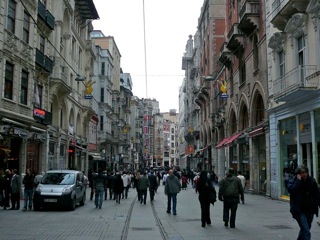
Back on the street, the sky was beginning to brighten up, but the wind was still fierce. And we were back in a monotone world. Turks have dark hair, dark complexions and drab, dark clothes. In public, at least, they are subdued—not like Greeks, or Neapolitans, who are even noisier. And building façades tend to be dark, too, blackened by the filthy fuel of earlier decades, if not originally grey. Even when the sun is shining, the light is thin, so different from the famous radiance of Attica—which still exists, despite pollution and urban sprawl.
But Istanbul’s beauty lies in other qualities: the water, the mosques and minarets rising over it and reflected in it, the mix of history—Byzantine, Ottoman, Venetian—the Anatolian sights, sounds, and smells, and the kind, ever-polite, and smiling people.
We walked back over the Galata Bridge, where fishermen by the hundreds congregate, buckets by their feet for their diminutive catch. Underneath the bridge, on the Pera side, is the open-air fish market, its presence announced by hundreds of swooping, squalling gulls.
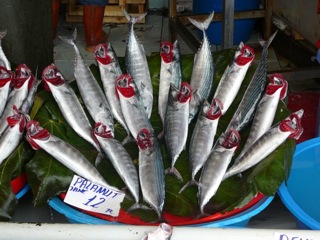
It was the hamsin season, when the anchovies are at their most abundant, but the stalls were a collage of larger silvery bodies. Grey mullet, sea bass, mackerel, and especially small tuna (palamut) lay on mounds of crushed ice. Not piled anyhow but in orderly rows, all with their gills splayed open—vermilion declarations of extra freshness. We bought some for supper and then sat shivering by the water to share a plate of exquisite fried anchovies and a salad of green and purple cabbage, carrots and tomatoes.
Those touches of red, again.
On Sunday, Daisy took me on a ferry ride to Asia and her favorite restaurant, Ciya, which was written up as “The Memory Kitchen” in the New Yorker (4/19/2010). Who knew? I only discovered that after the fact. It’s actually three restaurants, looking like all the other kebab houses on that street. And it was a struggle to decide which one to patronize—one’s mostly meat, the other entirely veg, and the third, and our choice, offering both.
I can still taste the puffed-up bread, the lamb-eggplant stew, the tamarind juice we had for dessert. It was the only reddish touch— not counting the ubiquitous little dish of hot pepper flakes that’s a permanent fixture of every Turkish table.
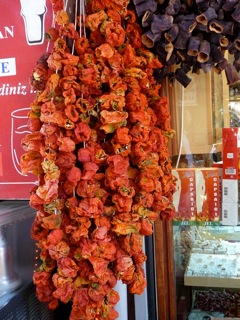
But a wander through the market district afterwards dazzled the eye and set us salivating with its red temptations. Shelves of jars of pickled peppers and tomatoes gleamed like fragments from stained glass windows. Board-like strips of paprika-coated pastourma (dried beef nowadays; once dried camel) hung in rows over trays of ruby slices. Curtains of dried red peppers used for stuffing dangled in open doorways. There was even a giant radish sliced open to show off its purply streaked flesh—of course I had to buy one.
The most spectacular red of all came later, at the so-called Egyptian or Spice Bazaar on the other side of Galata Bridge from the fish market. There the pyramids of chili pepper flakes of varying intensities had me swooning. To one with an insatiable hot tooth, this sight—repeated dozens of times—brought me close to ecstasy. I felt cosseted by their soft brilliance, their delectable symmetry, their promise of exciting meals.
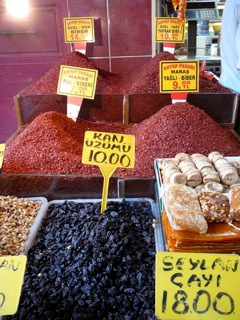
From then on the color red seemed to pop up everywhere: the trams, the flag, the faded pink façade of Agia Sophia, the red sesame-ring carts . . . even the rooftops viewed from a fancy penthouse bar proved to boast more than a smattering of russet tiles.
Back in Athens, my flamboyant bag buoys my spirits even during strike days, while the memories of my rosy tour of Daisy’s Istanbul glow gently, aided by a pinch of carmine pepper.
And so you can replicate at least one of them, here is her recipe for Red Lentil Soup. She says she makes it up as she goes along, but it isn’t exactly rocket science, so don’t worry about exact amounts.
Fry onions, carrot, garlic and a bit of chili flakes in olive oil.
Say 2 onions, a big carrot,
Half a kilo red lentils added to that when mooshy, water, stock cube (to taste) or just s and p. (Watch closely—they do absorb lots of water; hard to predict how much, though.)
Boil until cooked, not very long, and then mash with a pot masher or whoosh with my magic wand mixer.
More red pepper at the end if nec. I like it spicy.
Oh I forgot, I also put in some cumin to taste.
I always have finely chopped parsley and spring onion to garnish when serving.